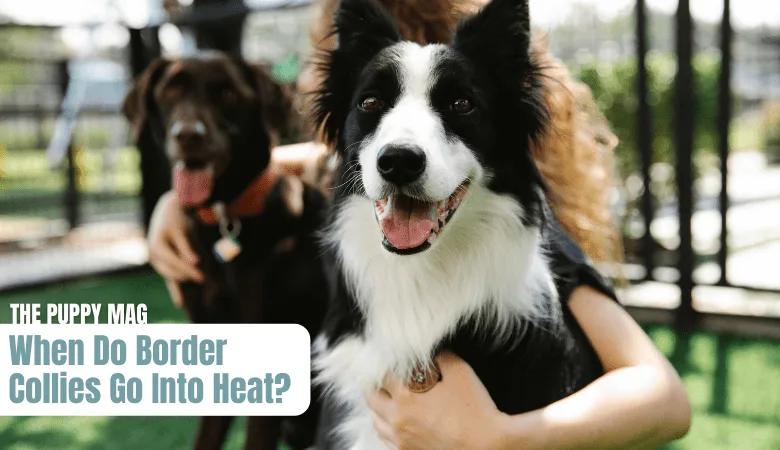Knowing when your Border Collie will go into heat isn’t so obvious and many owners understandably have a lot of questions on this topic.
This article clears everything up and cover the most commonly asked questions surrounding Border Collies and their heat cycles.
This article explains:
– When border collies go into heat
– The signs to look out for
– How long collies stay in heat
– How often heat cycles last
– The four different stages of each heat cycle
– How to care for your collie in heat
– Breeding questions
Let’s get into it!

Table of Contents
When Do Border Collies Have Their First Heat Cycle?
Most Border Collies will go into heat between 6-8 months of age. However, some border collies may go into heat sooner or later than this, which is still completely normal.
For some it could be as early as 4 months, and others as late as 16 months.
The most important takeaway from this is to know that nothing is set in stone!
The 6-8 month range is where most collies have their first heat, not all.
There are certainly cases of Border Collies experiencing their first heat at 5 months of age, and other reports of collies being 16 months of age before their first heat.
And the catch is that there’s no real way for you to know in advance.
This brings me onto the next section, signs to watch out for!
11 Signs That Your Border Collies Is Going Into Heat
So what are the signs to watch out for that mean your Border Collie is going into heat? This is by far the next most common question. So let’s cover them!
Signs your Border Collie is going into heat:
● Bleeding & blood spots
● Blood-colored discharge
● Swollen vulva
● Excessive licking in the genital area
● Urinating more regularly
● Paying extra attention in general to her genital area
● Aggressive towards male dogs (not ready to mate)
● Change in temperament (mood swings, aggression, anxiety)
● Change in energy
● Change in appetite
● Holding her tail differently
Again, just like with timing, the signs you will see can vary and some collies will exhibit certain signs more prominently than others. Some collies might bleed significantly, whereas some others may not appear to have bled at all!
However, the majority of females WILL demonstrate at least one or two of the most common primary signs: bleeding, discharge, a swollen vulva, or paying more attention to her genital area.
Being extra observant of your collie on a daily basis will allow you to notice any changes to what’s normal sooner rather than later. And that’s the secret!
Recommended Read: When do border collies stop growing and reach full size
How Long Do Collies Stay In Heat?
Border collies usually stay in heat for around 3 weeks (21 days) give or take a few days either side.
The first 8-10 days your collie won’t want to mate, and in the last 8-10 days, she will be willing and capable of getting pregnant.
Though there are technically four stages (explained below) the first two are the most notable, and make up the duration of when we consider a dog to be in heat.
More on heat cycle stages below!
How Often Do Border Collies Go Into Heat?
Most Border Collies will have up to two heat cycles per year.
With some having only one heat cycle every 16 months. Heat cycle frequency varies for all collies, with the maximum frequency being every once every six months.
The frequency depends on many things from genetics, health, and diet, lifestyle, and even her physical size. Smaller collies may experience their heat cycle more frequently than larger collies.

Psst! You gotta check out Brain Training For Dogs. It’s a scientifically-proven method for improving a dog’s behavior and intelligence. With these specific brain training exercises, you can help your collie become more obedient and less destructive without a fuss. Okay back to the post!
The Four Stages of Your Border Collie’s Heat Cycle
There are four stages to your collies’ heat cycle. Each stage of your collie’s heat cycle will mean something different, so it’s important to be aware of what that is.
Your collie will also exhibit different signs, depending on which stage of her cycle she is in.
1. Proestrus Stage
The very first stage is called the proestrus stage, and it usually lasts between 8-10 days. During this stage, your collie’s body will be getting ready to mate and conceive. But during the proestrus stage, she WILL NOT want to mate. So aggression towards males to keep them away is typical.
The proestrus stage usually lasts between 8-10 days in most collies, although this can vary by a few days in either direction.
⭐ Signs of the proestrus stage:
● Swollen vulva
● Tail tucking
● Bleeding
● Discharge
● Licking of the genital area
● Aggression towards males
2. Estrus Stage
The estrus stage comes next and is where your collie is fertile and ready to mate. She will be receptive towards males and will likely keep her tail held to the side when any are nearby.
During this stage, she is also likely to urinate more and be aggressive towards females.
The estrus stage usually lasts between 8-10 days in most collies, again this might vary by a few days in either direction.
⭐ Signs of the estrus stage:
● Frequent urination
● Holding tail to the side
● Will accept males
● Can be aggressive towards females
● Discharge might change color, consistency or slow down
3. Diestrus Stage
The diestrus stage follows the estrus stage and will be the moment at which your collie’s body returns to normal. If your collie has not been impregnated, this stage will take around a further 7 days after the estrus stage.
However, if she has been impregnated, this stage will last for the duration of the 60-70 days until the birth happens.
⭐ Signs of the diestrus stage:
● Vulva will return to normal size in around 7-10 days
● Discharge will also reduce until stopping completely
4. Anestrus Stage
The anestrus stage is the final stage that is considered the resting stage.
Essentially your border collie remains in this stage until the entire heat cycle starts again from the proestrus stage.
Tips On Caring For Your Border Collie In Heat
Being prepared for when your collie goes into heat all comes down to timing. If you know the signs to look out for (as listed above), you’ll have the time to be prepared.
Here are some of the best tips we know that will help you care for your Collie when she’s near, and in, her heat cycle.
1. Avoid letting her outside in the yard alone
Believe it or not, males will be able to smell your collie entering into heat from many miles away and will encourage them to reach her. It’s no exaggeration to say that some males would do all they can to enter your yard.
Additionally, once your collie is in her estrus stage, she herself might try escaping in order to find a partner. Always supervise her outside. Ideally, use a leash, even for potty breaks.
2. Always use the leash when she’s in heat
Whether you’re going for a walk or letting her outside in the yard for a potty break, using the leash is a must. When she herself is IN heat, the chances of her running off or escaping are very high. This happens much more than owners think. Please don’t take that risk.
3. Be accepting of her mood swings
All collies will react differently, some exhibit extra clinginess, and some will resort to nesting behavior and want to stay in their bed. Whatever it is, know that it’s only temporary and will pass.
Additionally, there’s a strong chance she will have dramatic mood swings and character changes so ensure the family knows that all of this is normal. Be comforting when she desires comfort and give her space when she seeks it.
4. Schedule a vet check-up
To remain on the safe side, it’s a good idea to visit your veterinarian for them to make an assessment and confirm everything is ok.
Remember, there’s nothing wrong with consulting your veterinarian, even if nothing appears to be wrong.
There are some known health implications that could happen after the heat cycle, so it’s worth contacting your veterinarian as a precautionary measure.
5. Be ready for the extra mess
From the bleeding, discharge, and increase in urination, it’s going to be a little messy. Be READY for that with extra towels protecting your floors, and other areas your collie usually goes.
Many owners resort to keeping their collie in one single room (due to the mess) but, ideally, if you take enough action beforehand, it will be more comfortable for your collie if she has the usual roam she normally does.
6. Keep her bed as clean as possible
Similar to above, her bed and sleeping area will also get quite messy and it’s advised to keep this as clean as possible. Whether this means washing the bed or switching it over on a daily basis, it’s best to reduce bacteria build-up where possible.
7. Consider hygiene pants
Hygiene pants or “doggy diapers” are a great way to keep the mess at bay as well as preventing unwanted pregnancy for when your collie is out on walks. Some dogs take to these pants and others hate them, but they are certainly worth trying. Most have replaceable pads inside.
When Can Border Collies Start Breeding?
Border Collies should not start breeding until after 3-4 heat cycles or until 2 years of age.
The reason for this is to give her enough time to mature both physically and mentally before undergoing such a biologically stressful event.
Although from a technical perspective, your Border Collie can be impregnated during her first heat cycle and give birth to a litter of puppies 50-60 days later, it’s not recommended.
So, there are two different answers, the technical answer like above, and the other is what’s recommended with the interest of your collie’s health and wellbeing in mind.
Even though many collies will have their first heat cycle at 6 months of age, they are technically still puppies themselves.
Breeding collies from this age can not only negatively affect them mentally and behaviorally, but also increase the chances of passing on health issues to the litter.
At the young age of 6 months, some would-be illnesses and diseases might not have been discovered. And in a collective effort to breed responsibly, we should only breed females and males that are in good health with no health issues.
Popular Read: Can border collies swim? Full swimming guide for collies
Most Recommended For Border Collies
Best Brushes For Shedding
No matter how much you brush your border collie, if you aren’t using the correct brushes, you won’t be getting the most out of each session! A simple Undercoat Rake and a Slicker Brush are by far the two best brushes to maintain your collie’s coat.
Best Online Training Program
Brain Training For Dogs has become increasingly popular with working dogs in the last few years and is now recognized as one of the best ways to train dogs, especially border collies, in the most stress-free, positive way.
Best Low-Calorie Treats
Keep your collie lean and agile by switching out the high-calorie treats and opting for something healthier. Zuke’s Mini Naturals contain only 2 calories per treat and are made from natural ingredients, making these some of the healthiest treats on the market.
Back to more Border Collie articles >>
